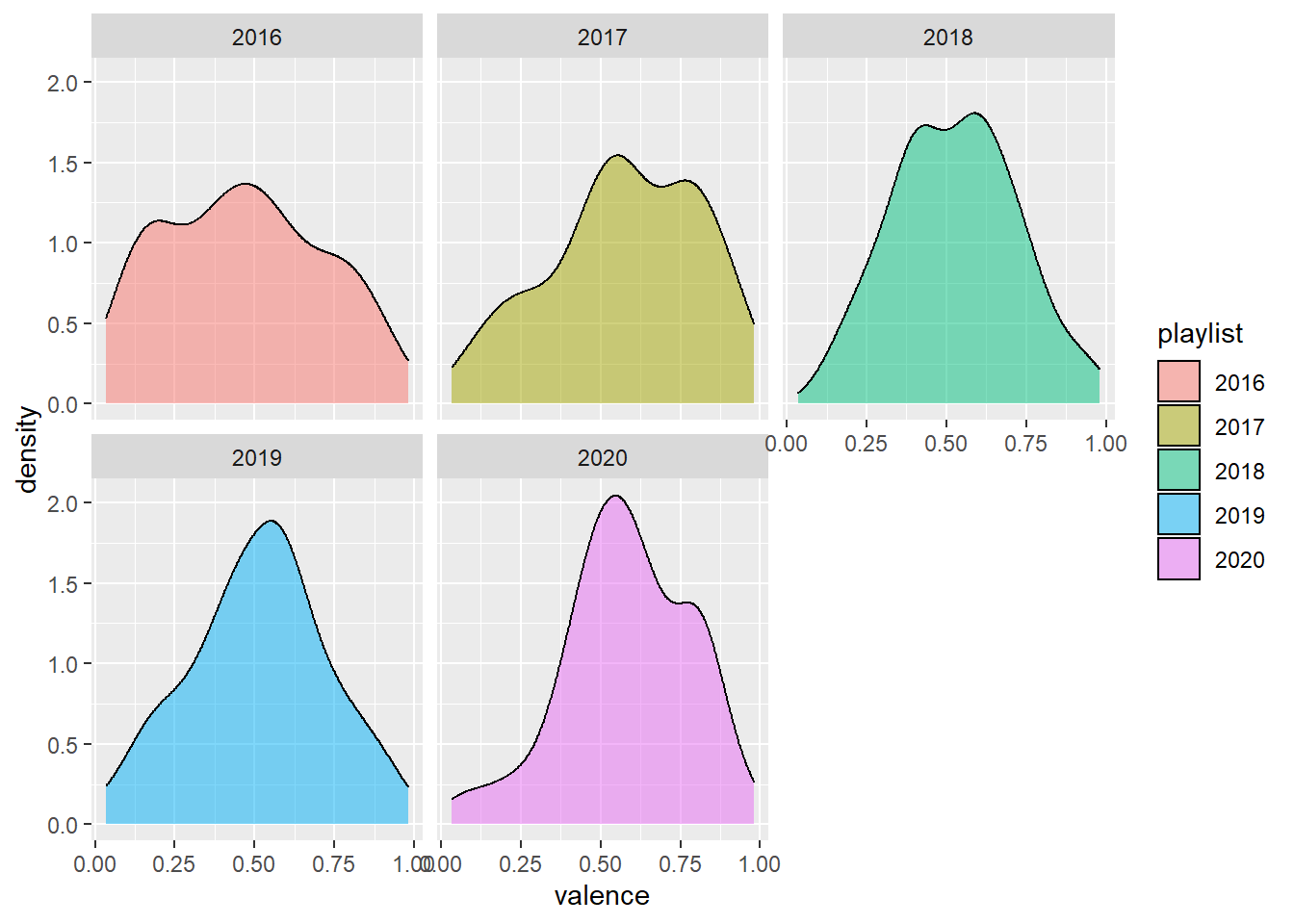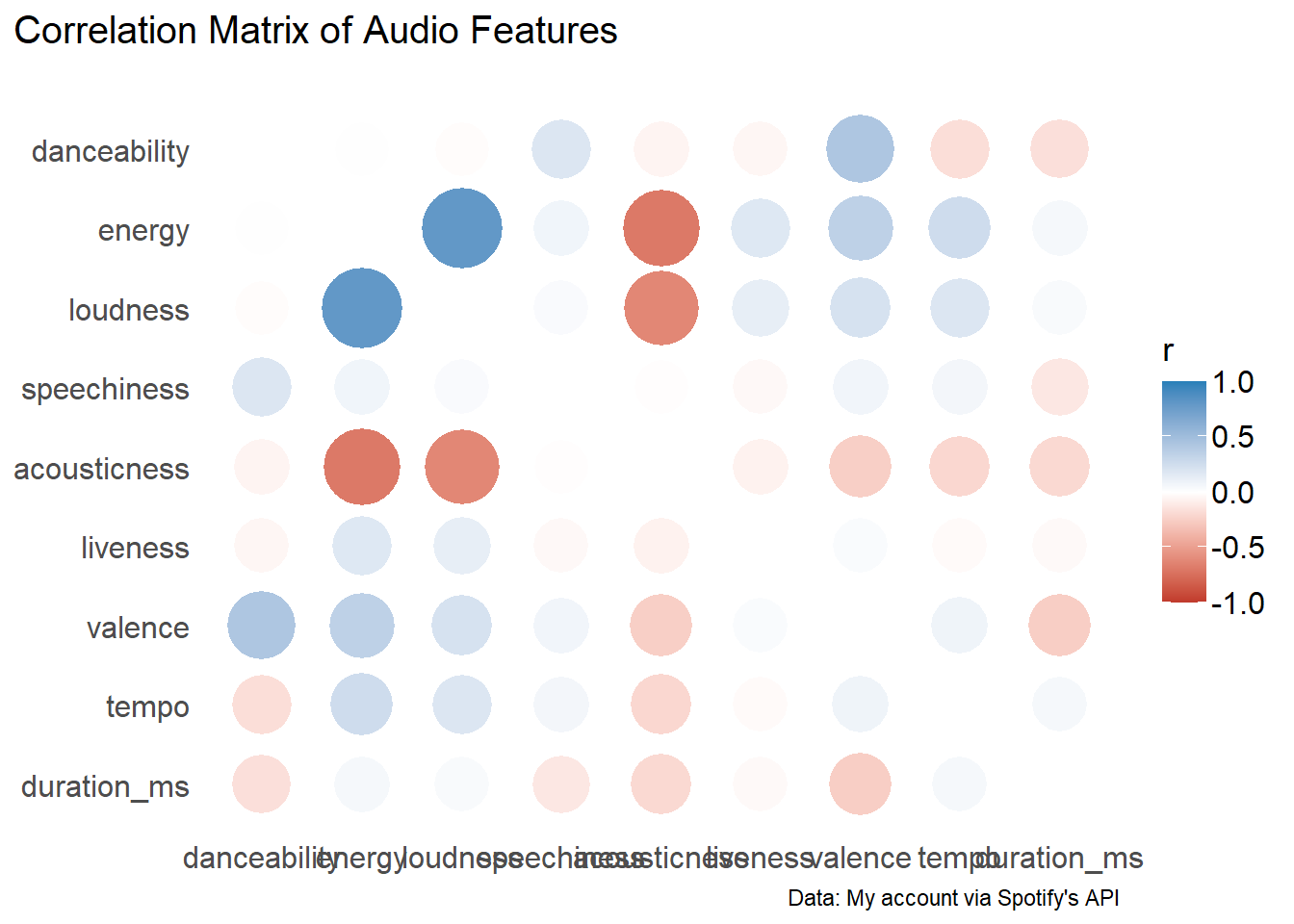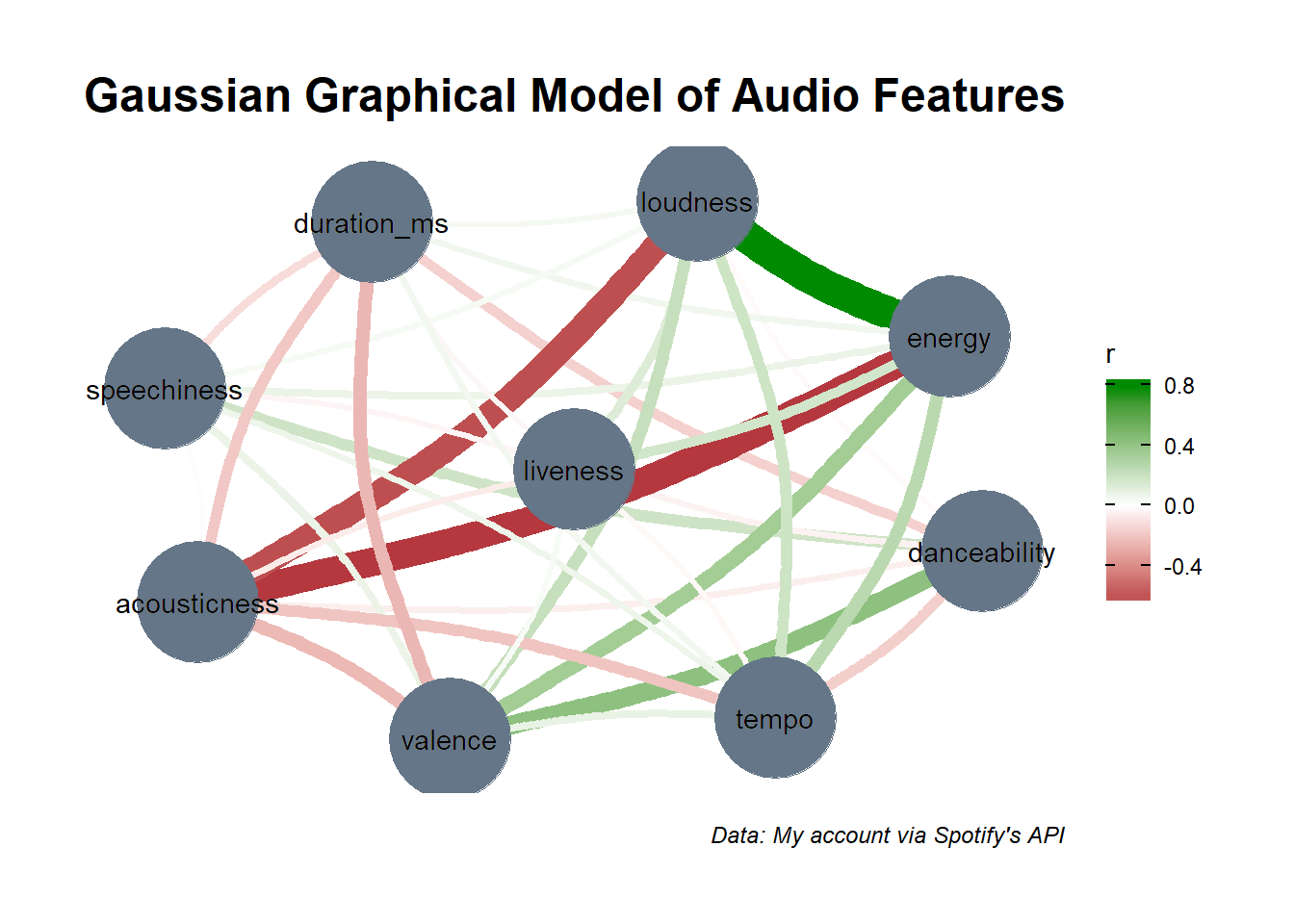Spotify Top 100 Yearly Playlist Analysis
Wesley, Why?
Every year Spotify comes out with our top 100 songs. Since I’ve been using Spotify from some time now, I have a couple playlists built up. I always wondered how my music taste has changed throughout the years. Wielding Spotify’s API and being able to access different Audio Features I thought it might be worth checking out.
Check out the GitHub repo
library(tidyverse)
library(ggdist) # Nice visualizations
library(patchwork) # Easy plot combinationsAfter using python to interact with Spotify (see Github) I downloaded my data and cleaned it up.
Let’s start coding
filepath_to_data <- here::here("content",
"post",
"2021-09-09-spotify_yearly_playlist",
"data")
playlist_2016 <- read_csv(here::here(filepath_to_data,
"clean_2016_playlist.csv"))
playlist_2017 <- read_csv(here::here(filepath_to_data,
"clean_2017_playlist.csv"))
playlist_2018 <- read_csv(here::here(filepath_to_data,
"clean_2018_playlist.csv"))
playlist_2019 <- read_csv(here::here(filepath_to_data,
"clean_2019_playlist.csv"))
playlist_2020 <- read_csv(here::here(filepath_to_data,
"clean_2020_playlist.csv"))Taking a look at one of our dataframes:
knitr::kable(head(playlist_2016))| song | feature | score | playlist |
|---|---|---|---|
| 1 | danceability | 0.674 | 2016 |
| 1 | energy | 0.667 | 2016 |
| 1 | key | 2 | 2016 |
| 1 | loudness | -7.385 | 2016 |
| 1 | mode | 1 | 2016 |
| 1 | speechiness | 0.0358 | 2016 |
Spotify’s Audio Features:
From The Spotify API Documentation we get a description of the different features.
acousticness- A confidence measure from 0.0 to 1.0 of whether the track is acoustic.danceability- Danceability describes how suitable a track is for dancing based on a combination of musical elements including tempo, rhythm stability, beat strength, and overall regularity. A value of 0.0 is least danceable and 1.0 is most danceable.duration_ms- The duration of the track in milliseconds.energy- Energy is a measure from 0.0 to 1.0 and represents a perceptual measure of intensity and activity.instrulmentalness- Predicts whether a track contains no vocals.liveness- Detects the presence of an audience in the recording.loudness- The overall loudness of a track in decibels (dB).speechiness- Speechiness detects the presence of spoken words in a track.tempo- The overall estimated tempo of a track in beats per minute (BPM)valence- A measure from 0.0 to 1.0 describing the musical positiveness conveyed by a track.
Wrangling!
Now some of the features are unrelated to what I want to look at so lets remove them
bad_features <- c("type", "id", "uri", "track_href", "analysis_url")
all_playlists <-
playlist_2020 |>
bind_rows(
playlist_2019,
playlist_2018,
playlist_2017,
playlist_2016
) |>
filter(!(feature %in% bad_features)) |>
mutate(score = as.numeric(score)) |>
mutate(playlist = as.factor(playlist))In order to plot, lets get our data into a wide format
wider_all_playlists <-
all_playlists |>
pivot_wider(
names_from = feature,
values_from = score
)Plotting
# Looking at the difference in valence
wider_all_playlists |>
ggplot() +
aes(x = valence, fill = playlist) +
geom_density(alpha = 0.5) +
facet_wrap(~ playlist)
Let’s break things down per-year
# Separating things
wide_2020 <- wider_all_playlists |> filter(playlist == "2020")
wide_2019 <- wider_all_playlists |> filter(playlist == "2019")
wide_2018 <- wider_all_playlists |> filter(playlist == "2018")
wide_2017 <- wider_all_playlists |> filter(playlist == "2017")
wide_2016 <- wider_all_playlists |> filter(playlist == "2016")I want to create a similar graph for each variable so let’s get functional
audio_feature_graph <- function(data, audio_feature) {
# For passing in columns into function
feature <- sym(audio_feature)
plot <- data |>
ggplot() +
aes(x = !!feature, y = playlist, color = playlist, fill = playlist)
plot <-
plot +
stat_slab(
size = .5,
alpha = .2
) +
stat_halfeye(fill = "transparent")
plot <-
plot +
theme_minimal() +
labs(y = "") +
theme(
legend.position = "none",
plot.title = element_text(hjust = 0.5)
)
return(plot)
}Aaaaaaaaand map!
all_audio_features <- c(
"danceability", "energy", "loudness", "speechiness",
"acousticness", "liveness",
"valence", "tempo", "duration_ms"
)
all_plots <- all_audio_features |>
map(~ audio_feature_graph(wider_all_playlists, .x))Add some description
all_plots <-
wrap_plots(all_plots) +
plot_annotation(
title = "Yearly Playlist Summary by Audio Feature",
subtitle = "Distribution of Audio Feature score by yearly 'Your top 100 songs 20XX'",
caption = "Data: My account via Spotify's API"
)
all_plots
Using the correlation package
The correlation package is apart of easystats and allows for easy correlation analysis (go figure)
Let’s look at a correlation matrix
library(correlation)
library(ggraph)
results <- correlation(
wider_all_playlists,
select = all_audio_features
)
corr_matrix <- results |>
summary(redundant = TRUE) |>
plot() +
labs(
title = "Correlation Matrix of Audio Features",
caption = "Data: My account via Spotify's API"
)
corr_matrix
We can also make a Gaussian Graphical Model (GGM) of our data.
ggm_graph <- results |>
plot() +
geom_node_text(label = all_audio_features, color = "black") +
labs(
title = "Gaussian Graphical Model of Audio Features",
caption = "Data: My account via Spotify's API"
)
ggm_graph
Conclusion
This was a fun little activity to look at how my music taste has changed over time on Spotify.
Reference
Makowski, D., Ben-Shachar, M. S., Patil, I., & Lüdecke, D. (2019). Methods and Algorithms for Correlation Analysis in R. Journal of Open Source Software, 5(51), 2306. doi:10.21105/joss.02306